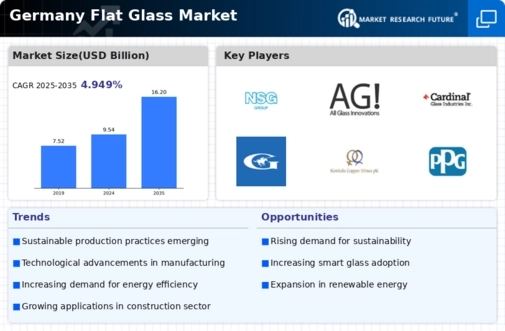The competitive landscape of the Germany Flat Glass Market is characterized by a diverse array of players, with a mixture of established multinational corporations and emerging local firms vying for market share. This sector has seen considerable growth due to increased demand in construction, automotive, and various industrial applications. The industry is driven by technological advancements and evolving consumer preferences, which prioritize energy efficiency and aesthetic appeal. Companies are focusing on expanding their product portfolios and enhancing their manufacturing capabilities to meet the rising demand for specialty flat glass products, including coated and laminated glasses that provide enhanced performance characteristics.
The market dynamics also reflect the influence of global economic trends and regulatory standards aimed at sustainability and environmental best practices, shaping the strategic decisions of the key participants. Zhangjiagang Huachang Glass has established a noteworthy presence in the Germany Flat Glass Market, leveraging its strengths in manufacturing high-quality glass products tailored for various applications. The company's advancements in production technology have resulted in a strong reputation for durability and efficiency, aiding its penetration into the German market.
Its focus on research and development allows Zhangjiagang Huachang Glass to offer innovative solutions that cater to the evolving needs of the construction and automotive sectors. By prioritizing cost-effectiveness without compromising quality, the company has made significant inroads into a market that values both affordability and technical excellence. The strategic partnerships and collaborations within Germany have further fortified its position, enabling the company to expand its distribution network while enhancing brand recognition among local consumers.
Schott AG stands as a prominent player in the Germany Flat Glass Market, known for its commitment to innovation and high-quality products designed for specialized applications. The company offers a diverse range of glass solutions, including those for architectural glass, optics, and technical glass, reflecting its extensive expertise. Schott AG’s strong market presence is supported by its extensive research capabilities and a focus on sustainable practices that align with Germany’s stringent environmental regulations. The firm has also benefited from mergers and acquisitions that have broadened its product offerings and enhanced its technological competencies.
By continuously investing in state-of-the-art manufacturing techniques and sustainable innovations, Schott AG not only strengthens its competitive edge but also reinforces its reputation within the German market as a trusted provider of advanced glass solutions suited for demanding industrial and commercial needs.


















Leave a Comment